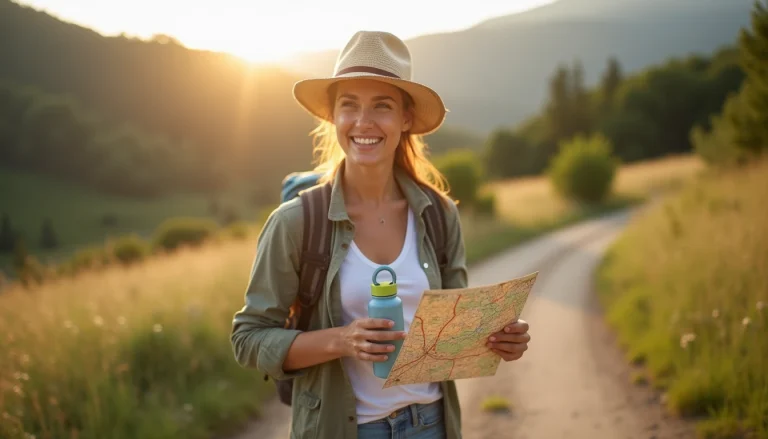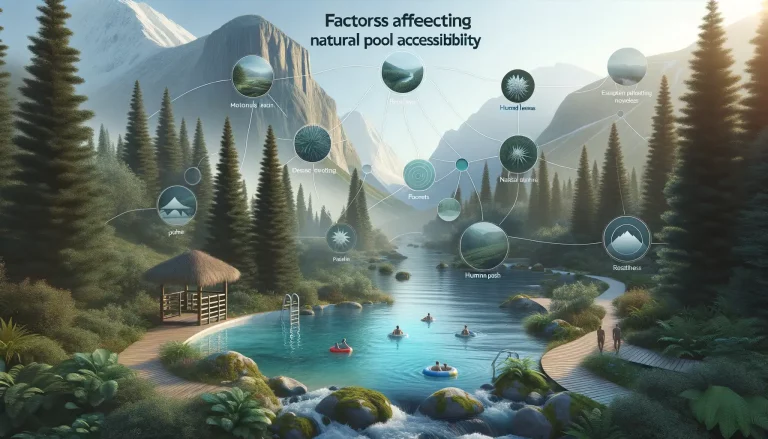You are finally on your long-awaited vacation. Do you want to enjoy it wisely? You can have a dream vacation without compromising your eco-values or safety. Here is a guide to ensure your vacation is as eco-conscious as it is unforgettable. From choosing the right destination to packing like a planet-friendly pro and getting an app to track a phone, every decision matters. Check yourself before you fly away!

Download Apps to Maintain Safety & Eco-Friendly Behavior
Certain recommendations will depend on your certain destination but with some apps on your smartphone you can manage safety and eco-friendliness all over the world. Make sure to download the following ones before departure.
- Number Tracker — location sharing to manage routes with your travel companions and stay safe everywhere without extra efforts
- HappyCow — a map of vegan and eco-friendly restaurants over the world
- Green Travel Choice — a calculator of carbon emissions for travelling
- PackPoint — a smart packing assistant in your pocket
- Too Good to Go — a map with discounts on unsold food in local eateries
Choose Eco-Friendly Destinations
Not all tropical paradises are created equal when it comes to environmental responsibility. Some destinations have gone the extra mile to integrate sustainable practices into their tourism infrastructure, actively protecting biodiversity, minimizing carbon emissions, and uplifting local communities. When booking your trip, opt for locations that have a proven track record of eco-conscious travel.
| Destination | Eco-Friendly Features | Why It Matters |
| Costa Rica | Carbon neutrality goals, 25% of land protected, renewable energy, eco-lodges | Model of sustainable tourism; supports both nature and local economies |
| Galápagos Islands | Strict visitor limits, carbon-neutral hotels, marine conservation areas | Limits human impact on sensitive ecosystems |
| The Bahamas | Solar-powered resorts, reef-friendly snorkel tours, community-based tourism | Promotes green tech and engages local stakeholders |
| Dominica | Focus on nature tourism, Waitukubuli National Trail, low-impact development policies | Protects rainforests and offers immersive, sustainable experiences |
Pro Tip: Use platforms like the Global Sustainable Tourism Council (GSTC) to verify if a destination or hotel meets credible sustainability standards.

What to Look For in a Destination
- Conservation programs (marine life, forest, wildlife)
- Policies regulating tourism volumes and waste
- Presence of eco-certification bodies
- Community involvement in tourism operations
Stay at Green Accommodations
Your accommodation has a direct impact on the local environment. Resorts with excessive energy use or poor waste management can harm local ecosystems. In contrast, green lodgings implement sustainability measures that help conserve water, reduce emissions, and support nearby communities.
Types of Eco-Conscious Stays
- Eco-Lodges
These properties are often nestled in natural settings and built with sustainable materials. They may feature:- Solar panels
- Rainwater harvesting
- Composting toilets
- Locally-Owned Guesthouses
Small, locally-run accommodations are not only more authentic but also reduce the carbon footprint associated with multinational chains. Money spent here is more likely to stay in the community. - Certified Green Hotels
Look for badges and certifications like:- Green Globe
- Rainforest Alliance Verified
- GSTC Approved Hotels
These ensure compliance with rigorous sustainability criteria.
Ask these questions when booking a stay:
- Do they use renewable energy?
- What are their waste management practices?
- Are local workers employed and paid fairly?
- Do they avoid single-use plastics and use biodegradable alternatives?
- Is the property certified by a reputable sustainability program?
If the hotel company has ecologically safe politics, they are likely to have all these answers on their website. If not, feel free to ask before booking. All those practices are not for green purposes only, they make your stay more comfortable and unique in general.
Pack Responsibly
Packing for a vacation frequently means buying many new and disposable plastic things. You can avoid it if you get ready consciously. It won’t just reduce the amount of litter you leave, but will also make your packing cheaper and lighter.
Here is the check-list of items to make your bags more sustainable:
- Reusable Water Bottle — to reduce plastic consuming and keep you hydrated
- Reef-Safe Sunscreen — to prevent coral bleaching caused by oxybenzone and octinoxate
- Bamboo Toothbrush & Shampoo Bars — biodegradable and plastic-free alternatives to traditional toiletries
- Collapsible Tote Bag — another way to use less disposable plastic items
- Lightweight Clothing — to reduce your luggage’s weight, make your commuting both comfortable and lessen carbon emissions from your flight
Participate in Sustainable Activities
Tropical destinations are bursting with opportunities for fun and exploration—but not all activities are created with sustainability in mind. The best experiences not only thrill you but also educate, conserve, and benefit local ecosystems and communities. Choose the right operators and experiences to enjoy your vacation and leave a positive impact.
Marine Adventures with a Purpose
Snorkeling and Scuba Diving are certainly top things to do when you’re finally near the ocean. But the wrong operators can do serious damage and exploit nature. Look for tours certified by organizations like PADI Green Star, Reef Check, or Blue Certified. These prioritize reef health and often include conservation education.
Top Sustainable Marine Activities:
- Snorkel in Bonaire National Marine Park (Caribbean) – Entry fees support coral restoration and marine patrols.
- Dive with eco-certified teams in Palau or Raja Ampat (Indonesia) – Areas known for rich marine biodiversity and conservation-first tourism.
- Kayak through mangrove forests in Belize – Low-impact, non-motorized travel that protects fragile marine ecosystems.
Land-Based Eco-Explorations
Tropical terrain offers jungles, volcanic peaks, unique birds and animals to see. You’ it all should be explored responsibly.
How to entertain without harming nature:
- Guided Nature Hikes: Visit places like Dominica’s Waitukubuli National Trail or Hawaii’s Nā Pali Coast Trail with licensed local guides.
- Waterfall Treks: Choose parks that limit foot traffic and enforce conservation rules to prevent erosion and habitat damage.
- Tree Canopy Tours: Opt for ziplines that use sustainable platforms and don’t disturb native wildlife.
Respect Local Wildlife
The lush landscapes and crystal waters are home to some of the planet’s most unique and endangered creatures. Respecting wildlife is a vital part of conservation and your personal safety. Interacting irresponsibly with animals can alter their behavior, harm ecosystems, and even put you in danger.
| Do’s | Don’ts |
| Observe animals quietly from a safe distance | Feed or touch wildlife |
| Join wildlife tours led by certified naturalists | Participate in photo-ops with wild animals |
| Use binoculars or zoom lenses instead of getting too close | Pick up shells, corals, or disturb nesting areas |
| Follow beach rules during nesting seasons (e.g., turtle eggs) | Shine bright lights or make loud noises near animal habitats |
Protect the Beach Ecosystem
While you are not interacting with animals directly, remember that they live everywhere in the tropical climate. When you are resting on the beach, remember those simple rules to leave the sand safe for creatures living in it:
- Flatten sandcastles after play to prevent obstacles for nesting or hatching turtles.
- Avoid beach bonfires in conservation zones—smoke and light can confuse animal behaviors.
- Respect signage about protected dunes or roped-off areas.
Reduce Your Carbon Footprint
While flying to a tropical paradise might seem unavoidable, there are plenty of ways to reduce your environmental impact before, during, and after your journey.
Smart Transportation Choices
Before You Book:
- Choose Direct Flights: Fewer takeoffs and landings = less fuel consumption.
- Fly with Eco-Conscious Airlines: Some use biofuels, carbon offsets, or efficient fleet designs.
During Your Trip:
- Use Public Transit or Bikes: Many islands have bike-friendly roads or e-scooters.
- Walk When Possible: It’s free, healthy, and leaves no trace.
- Rent Green: If you must drive, opt for electric or hybrid vehicles.
Carbon Offsets: Worth It?
Yes, when done through reputable programs. Carbon offsets help balance the emissions you can’t avoid by investing in environmental projects like reforestation, wind farms, or methane capture.
Recommended Offset Providers:
- Gold Standard
- CarbonFund.org
- ClimateCare
Tip: Calculate your trip’s emissions using online tools (e.g., MyClimate or Atmosfair) to buy accurate offset packages.
Support Local Economies
An eco-conscious vacation is not just about the environment—it’s also about the people. Many tropical destinations rely heavily on tourism, and choosing to spend your money wisely can uplift communities, preserve cultural heritage, and foster long-term sustainability. Rather than pouring profits into international chains, you can ensure your spending directly benefits the locals who safeguard the destinations you visit.
- Shopping at Artisan Markets — Helps to avoid imported souvenirs and provides you with locally crafted items like woven baskets, hand-carved jewelry, or traditional textiles.
- Dining at Family-Owned Restaurants — Reduces your carbon footprint and supports local agriculture
- Using Local Tour Guides and Operators — Encourages cultural exchange and ensures money stays in the community
- Taking Cooking or Craft Workshops — Provides income for locals and promotes cultural preservation
- Staying in Community-Based Lodges — Helps rural communities build sustainable tourism businesses
How to Identify Authentic Local Businesses
- Look for menu items that feature locally sourced ingredients.
- Ask your hotel or host for recommendations beyond the tourist hotspots.
- Visit cooperatives or community-funded enterprises (check online travel forums or sustainability blogs).
Leave No Trace
Whether you’re hiking a jungle trail or lounging on a beach, the best way to preserve nature is to leave it exactly as you found it. The “Leave No Trace” principle is simple but powerful: take only memories, leave only footprints.
- Dispose of waste responsibly
- Avoid single-use plastics
- Participate in beach cleanups
- Bring reusable containers & utensils
- Use biodegradable toiletries
We’ve created quite a long list to check your travel habits. Use it to change your behavior to a greener and healthier one without too much effort — and we are always ready to guide you!





